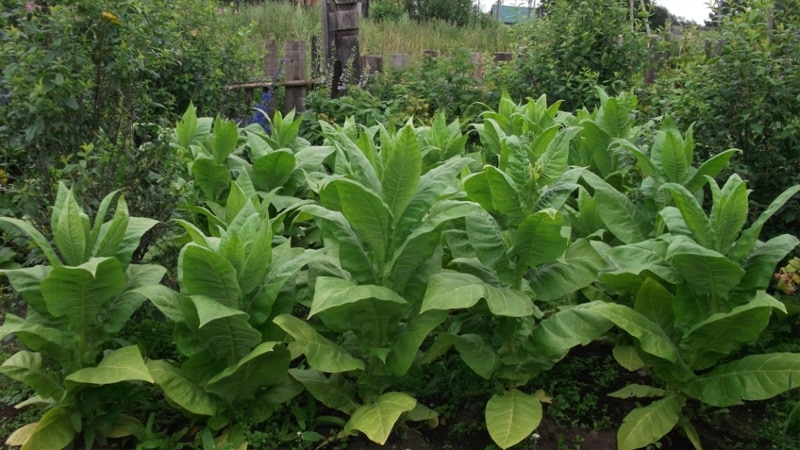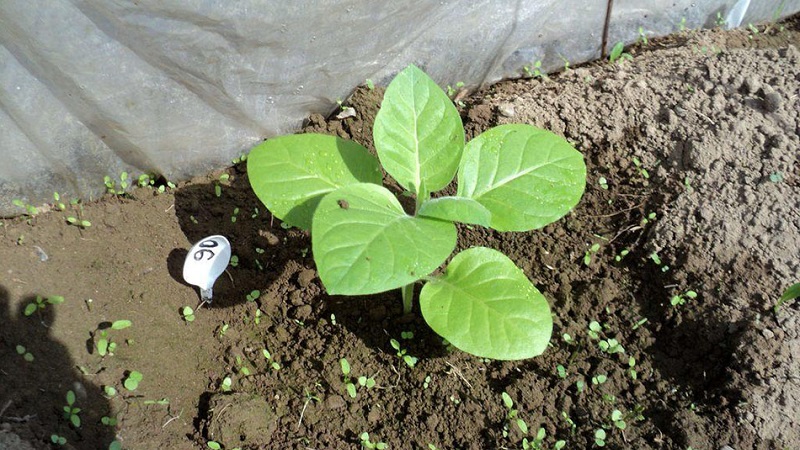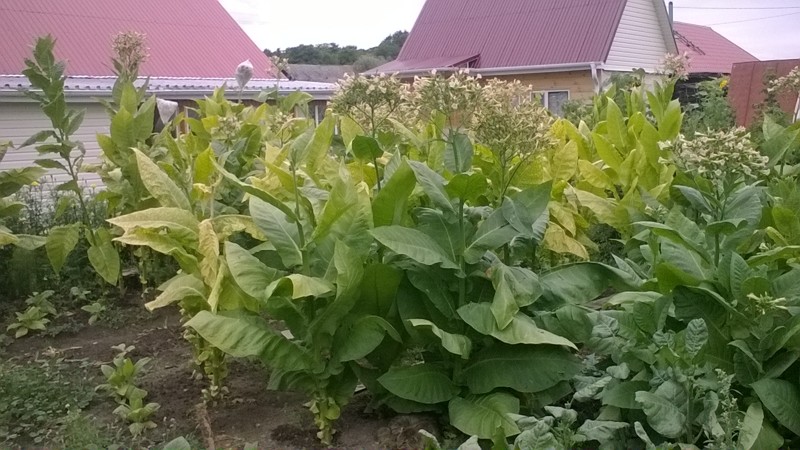Technology for growing tobacco in the open field, greenhouse and at home
Tobacco is a warm and moisture-loving plant. The preferred regions for its cultivation are southern, with a hot climate. In the middle lane, this plant is cultivated in greenhouses. Growing tobacco from seeds is no more difficult than growing tomatoes. How to plant tobacco, fight pests and diseases, process leaves for storage and use, we will tell in the article.
The content of the article
Is it worth growing smoking tobacco

Many gardeners are asking this question. On the one hand, self-grown tobacco is obviously of better quality than purchased in a store. On the other hand, to provide an annual plant supply, standard 6 acres may not be enough - the rest of the crops also need space.
If you just want to experiment, it is enough to select a garden bed in a greenhouse or in the open air. Large-scale cultivation will require a significant area.
Important! Before sowing tobacco, you should familiarize yourself with its varieties and their characteristics. Two types of cigarette tobacco are grown in our country. In both Americas - cigar.
The advantages and disadvantages of samosad
A significant plus of self-growing tobacco is its purity. Purchased cigarettes, in addition to the main ingredient, contain resins, various impurities, aromatic additives, bringing additional harm to the health of the smoker.
Another advantage is savings. The average cost of a pack of cigarettes is 100 rubles. The family budget will be saved at least 30 thousand rubles. per year when switching to self-garden.
Parts of tobacco that are not used for smoking purposes are excellent at fighting pests of garden plants. The disadvantages of growing are that it is almost impossible to predict varietal characteristics.
The end result will depend on many factors:
- soil composition;
- weather conditions;
- fertilization;
- plant care.
Choosing a tobacco variety for self-cultivation, take into account not only its yield, but also its adaptability to various climatic conditions.
How to grow tobacco

In most regions of the Russian Federation, samosad is cultivated by seedlings. Since the growing season for the plant is long, sowing is done already in February - early March. This culture loves long daylight hours, and therefore it is transplanted into the ground no earlier than the end of May - beginning of June.
Tobacco grows well in almost any soil, but the quality of the finished product depends on the content of nitrogen, phosphorus and potassium in the soil.
Important! You cannot grow a plant in the same place. It is planted on an old plot not earlier than after 4 years. After tobacco, the soil needs abundant feeding. Samosad greatly impoverishes the land, drawing out a significant amount of minerals during the period of intensive growth.
Seed preparation and germination
2-3 days before sowing, the planting material is etched with a weak solution of potassium permanganate, washed and dried. Insofar as tobacco seed very small, the best way to germinate is to place them on the surface of a folded wet toilet paper in several layers.
When the seeds hatch and give roots, carefully with the help of tweezers, the seedlings are transferred to peat pots or seedling boxes.
Important! When directly sowing seedlings in containers or pots, the seeds are evenly spread on a damp surface, lightly sprinkled with earth and pressed down with glass. When green shoots appear, the glass is removed, and the seedlings are illuminated with a phytolamp.
Soil preparation
Tobacco loves loose soils, therefore, for germination, they acquire ready-made soil for garden plants or flowers. In the composition of such soil mixtures there is peat, which makes the earth loose.
Prepare soil for seedlings on their own in the following proportions:
- sand - 1 part;
- humus - 2 parts;
- garden soil - 2 parts.
The soil in the garden or in the greenhouse is prepared in the fall. To do this, remove all organic residues, dig deep into the beds and apply mineral fertilizers with a high content of nitrogen and potassium.
In the spring, after warming up, the soil is once again dug up and harrowed. Before planting, the seedlings are abundantly moistened and fertilized again.
Important! The land from the site is replete with microorganisms, fungi, pests and weed seeds. Before planting tobacco, it is etched with a strong solution of potassium permanganate, and as foreign plants appear, they are promptly weeded out.
Planting seedlings

Prepared and germinated seeds are planted in individual containers - disposable plastic cups or peat pots. Seeds, sown directly into seedling boxes, dive when 3-4 leaves appear.
In containers for seedlings, drainage holes are made so that there is no stagnation of water and soil acidification. Otherwise, the plants will die.
Seedlings are planted in moist soil and placed in a place well-lit by the sun. A glazed and insulated loggia is ideal. Backlighting is necessary until the seedlings are planted in the ground or greenhouse.
Watering is carried out in 1-2 days as the soil dries up. 2 weeks before planting in the ground, the seedlings are hardened. To do this, the frequency of watering is reduced and containers with seedlings are transferred to the greenhouse, which is ventilated both day and night. In the absence of a greenhouse, the seedlings are left outside, but at night they are brought into a cool room.
After the end of hardening, the seedlings are placed in prepared beds, pre-moistened. In greenhouses, it is best to make high beds, and in the open field, tobacco is planted in the ridges. This will protect from recurrent frosts and facilitate hilling during the growing season.
Care
Plants planted in the ground or greenhouse are watered in a timely manner, 3-4 times during the growing season they feed, stepchild and cut off the tops during budding.
For watering, it is best to use drip irrigation. It delivers moisture directly to the roots and prevents weeds from developing.
Fertilizers are applied for the first time 10-12 days after planting the seedlings in the soil. Hilling is carried out immediately after it. The second mineralization is carried out in a month. The third top dressing is applied at the beginning of flowering. Since potassium, phosphorus and nitrogen are vital for tobacco, fertilizers are chosen based on the high content of these elements.
The highest productivity of fertilizers for tobacco is associated with their introduction directly into the topsoil - the root system provides nutrition to the plant.
After making each top dressing, the tobacco is spilled and 2-3 lower leaves are cut off. This will allow the formation of powerful stems on which marketable leaves will develop.
Each tobacco leaf has a stepson. They must be pinched when they reach a size of 2-2.5 cm. If you do this earlier, the stepson will grow up again. If later, useful leaves will receive less nutrition.
When the budding process begins, the tops of the tobacco are cut off. This stimulates the growth of powerful green mass. Otherwise, most of the nutrition will go to the formation of the fruit.
Important! To obtain seed, it is enough to leave 2-3 of the most developed and beautiful plants and not cut off the buds from them.

Potential diseases and pests
Tobacco is often susceptible to diseases, some of which are viral, with which it is useless to fight. These include tobacco and cucumber mosaics, white speckled and bronze. If signs of viral infections are detected, diseased plants are weeded out and burned.
To combat fungi (root and seed rot, powdery mildew, peronosporosis, dry white spot), 50% Benlata powder and polycarbacin are used.
The most dangerous pests of tobacco:
- Wire worm... It damages the roots, penetrates through them into the stems and eats them out from the inside. It is almost impossible to cope with it, so prevention is important. To do this, 2 weeks before planting the seedlings, the soil is treated with a 12% solution of hexachlorane and harrowed to a depth of 3-4 cm.
- Tobacco thrips. Bites the leaves and sucks the juice out of them. Affected plants are worse stored, ferment harder and lose their taste. Treatment with insecticides saves from this pest.
- Peach aphid... It is dangerous not only because it affects the leaves. It carries incurable diseases, depletes plants and reduces yields. To combat insects, they are treated with metathion or "Rogor".
In order to prevent the spread of diseases or the reproduction of pests, plants are regularly examined for lesions. If diseases or insects are detected, measures are immediately taken to destroy pests and treat diseases.
Harvesting
As soon as the tobacco leaves stop growing, they begin to harvest them. To do this, cut off the lowest leaves, then move on to the middle ones. The upper ones are cut off last. Cleaning is carried out in the evenings, in dry weather.
How to grow tobacco at home

On a windowsill or balcony, self-garden does not feel very good. He needs a large feeding area, constant ventilation, an abundance of moisture and regular feeding. There is not enough space to get full-fledged plants at home.
But you can also grow tobacco at home. Germinate seeds and prepare the soil in the same way as for seedlings. After diving, the containers must be at least 30 cm in diameter and 50 cm in depth. Place the pots of tobacco in such a way that the plants are evenly illuminated and ventilated.
Since tobacco is a culture of long daylight hours, phytolamps will be required for additional lighting for at least 10-12 hours a day.
What to do next
The collected leaves are dried in a dark, ventilated room at a temperature not higher than + 25 ... 30 ° C. When dried, the leaves naturally ferment.
Fermentation carried out during storage... Certain varieties of tobacco reach their final varietal quality over several years when stored in oak barrels or special bags.
At home, dry leaves without green spots are selected for fermentation. In the presence of chlorophyll, the fermentation process is impossible. The leaves are abundantly moistened with water from a spray bottle, folded into a tight pile and wrapped in plastic wrap.
A day later, the midrib is removed from each leaf. Finished leaves are dry, elastic and do not break at the folds. They are cut into strips and stacked in glass jars, filling them no more than 2/3. Cover with metal lids and put in an oven preheated to + 50 ° C.
Within a week, the tobacco is fermented, while periodically the jars are taken out and shaken so that the process proceeds evenly.
Storage of finished tobacco
After fermentation, the crushed leaves are dried again in a dark, ventilated room and transferred to a container for a long storage.
Do not store fermented tobacco in plastic or metal containers. It is best to use thick paper or linen bags, glass jars with a lapped lid.
Conclusion
Smoking is definitely an addiction. But you can reduce the harm caused by nicotine by growing and using good quality tobacco without additional additives.Difficulties in cultivation are caused only by a large number of pests and diseases, which must be dealt with even before planting seedlings in the ground.
Correctly selected variety tobacco for smoking and adherence to cultivation technology guarantees a high-quality and plentiful harvest.